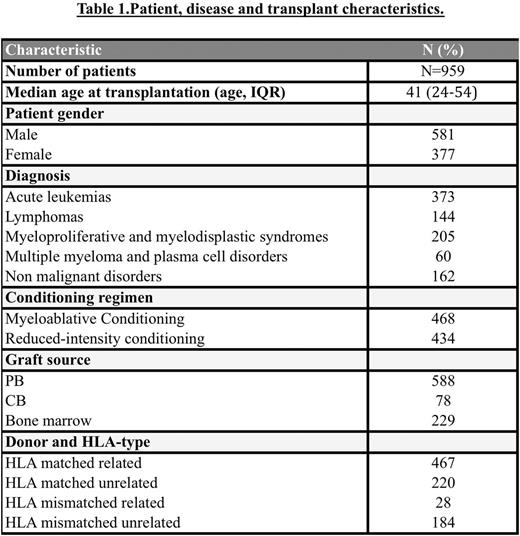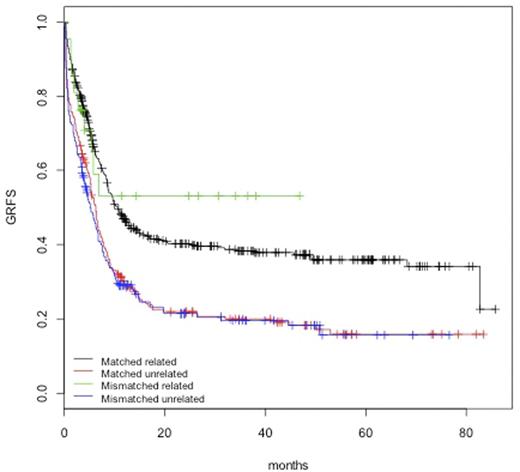Abstract
The cure of hematologic disorders by allogeneic hematopoietic stem cell transplantation (HSCT) is often associated with major complications resulting in poor outcome, including acute and chronic graft-versus-host disease (GVHD), relapse and death. Classical endpoints such as overall survival (OS), desease free survival (DFS) and non relapse-mortality (NRM) had become more and more unsuitable for transplant research because of their inability to a dynamic mesure of transplant-associated comorbidity. For this reason several composite endpoints taking into account also GVHD-associated comorbidity were proposed in the last years. GVHD free/relapse free survival (GRFS), proposed by Holtan et al (Blood 2015), includes grades 3-4 acute GVHD, systemic therapy requiring chronic GVHD, primary disease relapse , or death for any cause considered as events. This endpoint seems to completely characterize the survival without mortality or ongoing morbidity.
With the intent to analyse the outcomes of our transplanted cohort, we retrospectively analysed GRFS of 959 consecutive patients receiving HSCT at Federico II University in Naples (n=119) and Saint-Louis Hospital (n=840) in Paris between 2007 and 2014, identifying prognostic factors associated with a better outcome and estimating the incidences of all components of this endpoint: rates of acute and chronic GVHD, disease relapse and death.
Patient, disease and transplant characteristics are listed in table 1. Median duration of follow-up after HSCT was 22.1 months (IQR: 5.6-51 months).
Cumulative incidence at day 100 of grade II-IV acute GVHD and grade III-IV were 42% and 16%, respectively. Cumulative incidence of chronic GVHD requiring systemic treatment at 1 and 5 years was 23% and 33%, respectively, diagnosed according to NIH criteria [14% of patients had score 1 (mild), 58% score 2 (moderate) and 27% score 3 (severe)cGVHD].
Cumulative incidence of relapse (considering all malignant and non-malignant diseases) was 26.7% (N=219) at 5 years.
Overall survival for the whole population was 57% (95%CI, 53.3-60.8) at 5 years and Disease free survival (DFS) and non-relapse mortality (NRM) were respectively 50% (95%CI, 46.6-53.8) and 23% at 5 years.
GRFS was 25% (95%CI, 21.8-28.5) at 5 years.
Factors identified as influencing GRFS based on univariate analyses were age higher than 45 years (HR=1.64, 95%CI, 1.40-1.92), bone marrow (BM) as stem cell source (HR=0.40, 95%CI, 0.32-0.50); reduced intensity conditioning (RIC) (HR=0.63, 95%CI, 0.53-0.74); disease type [non-malignant disorders: HR=0.24, 95%CI, 0.17-0.33; myelodysplastic and myeloproliferative syndromes (MPN/CML/MDS): HR=1.34, 95%CI, 1.10-1.63; whereas other diagnosis did not influence GRFS] and than unrelated donor (matched: HR=1.71, 95%CI, 1.41-2.07;mismatch:HR=1.81, 95%CI, 1.48-2.23). Based on a multivariable Cox model, only diagnoses (non-malignancies, HR=0.27, 95%CI, 0.19-0.38 and MPN/CML/MDS, HR= 1.35, 95%CI, 1.11-1.65), and HLA unrelated graft (matched, HR=1.42, 95%CI, 1.17-1.73 and mismatched, HR=1.55, 95%CI, 1.26-1.92) remained associated with the outcome (Figure 1 and 2).
GRFS could represent the ideal endpoint following HSCT. It differs significantly based upon type of disease and donor type, essentially. This composite indicator yields more information regarding complications of HSCT than the simpler measurement of OS or DFS. Its use willbetter compare these clinically important outcomes that accompany disparate HSCT techniques. All examined prognostic factors could enhance our ability to optimally judge the risk and the probability of true recovery after allogeneic HSCT. Our data support the use of this composite endpoint to describe HSCT outcome, and also pave the way for the investigation of novel endpoints, which may also track the dynamic changes of post-transplant events in the long-term. These retrospective data represent the background to investigate the impact of novel strategies of HSCT aiming to improve the outcome of HSCT, as detectable, by using more sensitive endpoints, tracking clinical events associated with detrimental long-term outcome.
Risitano:Alexion Pharmaceuticals: Other: lecture fees, Research Funding; Novartis: Research Funding; Alnylam: Research Funding; Rapharma: Research Funding. Peffault de Latour:Pfizer: Consultancy, Honoraria, Research Funding; Amgen: Research Funding; Novartis: Consultancy, Honoraria, Research Funding; Alexion: Consultancy, Honoraria, Research Funding.
Author notes
Asterisk with author names denotes non-ASH members.




This feature is available to Subscribers Only
Sign In or Create an Account Close Modal